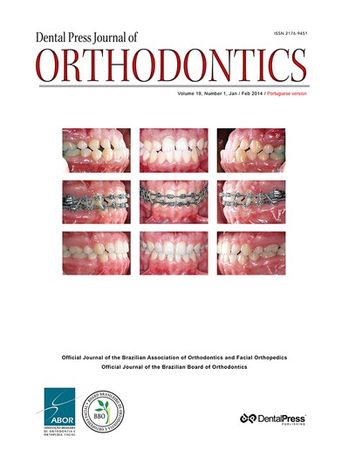Writing a scientific paper: Where to start from?
It is not our aim, in the next few lines, to make our reader become a contumacious scientific writer. Scientific writing requires practice and there are only a few courses that can guide us to a shortcut. However, there are some useful pieces of advice that I pass on based on the experience I have...
Autores: David Normando,
messages.RevistaAutores:
LEIA MAIS
orthodontics highlights
During orthodontic treatment, interproximal wear is a procedure generally practiced by orthodontists. It is recommended for tooth size adjustment in case of Bolton discrepancy; obtaining space in the arch in borderline cases, being an alternative to tooth extractions; dental contours for...
Autores: Matheus Melo Pithon,
messages.RevistaAutores:
LEIA MAIS
Force distribution is more important than its intensity!
A common question about root resorption is raised in orthodontic practice: What is more important, the intensity of force or its distribution along the root, periodontal and alveolar structures? Diffuse distribution of forces applied to periodontal tissues during tooth movement tends not to...
Autores: Alberto Consolaro,
messages.RevistaAutores: Root resorption, Induced tooth movement, Orthodontic forces,
LEIA MAIS
What is the meaning of this lowercase “p”?
Most health professionals are resistant to statistics. There is nothing inconsistent about it: if they liked Mathematics as a profession, they would have chosen a career in the exact sciences. Clinical dentists are not different: most of them prefer to avoid greater proximity to, and as a...
Autores: José R. P. Lauris,
messages.RevistaAutores:
LEIA MAIS
An interview with Kazuo Tanne
Professor Kazuo Tanne has a degree in Dentistry by the University of Osaka where he also received the title of PhD in Orthodontics. From the 1st of July, 1993 to the 31st of March, 2013 he was the head of the Department of Orthodontics and Craniofacial Development Biology at the University of...
Autores: Fábio Lourenço Romano, Matheus Melo Pithon, Rogério Lacerda Dos Santos, Emanuel Braga Rêgo,
messages.RevistaAutores:
LEIA MAIS
Dental and skeletal components of Class II open bite treatment with a modified Thurow appliance
Introduction: Due to the lack of studies that distinguish between dentoalveolar and basal changes caused by the Thurow appliance, this clinical study, carried out by the School of Dentistry — State University of São Paulo/Araraquara, aimed at assessing the dental and skeletal changes induced...
Autores: Ary Dos Santos-Pinto, Peter H. Buschang, Helder Baldi Jacob,
messages.RevistaAutores: Orthopedics, Angle Class II malocclusion, Open bite,
LEIA MAIS
An assessment of the maxilla after rapid maxillary expansion using cone beam computed tomography in growing children
Introduction: With the advent of cone beam computed tomography (CBCT), it is now possible to quantitatively evaluate the effects of rapid maxillary expansion (RME) on the entire maxillary complex in growing patients. Objective: The purpose of this study is to use three-dimensional images to...
Autores: Peter H. Buschang, Ki Beom Kim, Rolf G. Behrents, Jessica L. Woller,
messages.RevistaAutores: Palatal Expansion Technique, cone-beam computed tomography, Orthodontics, Cranial sutures,
LEIA MAIS
Dentoskeletal effects of Class II malocclusion treatment with the Twin Block appliance in a Brazilian sample: A prospective study
Objective: The aim of this study was to assess the dentoskeletal effects of Class II malocclusion treatment performed with the Twin Block appliance. Methods: The experimental group comprised 20 individuals with initial mean age of 11.76 years and was treated for a period of 1.13 years. The...
Autores: Fabrício Pinelli Valarelli, Rodrigo Hermont Cançado, Luciano Zilio Saikoski, Karina Maria Salvatore De Freitas,
messages.RevistaAutores: Angle Class II malocclusion, Functional orthodontic appliances, Skull circumference, Prospective studies, Treatment outcome,
LEIA MAIS
Dental and skeletal changes in patients with mandibular retrognathism following treatment with Herbst and preadjusted fixed appliance
Objective: To assess the dentoskeletal changes observed in treatment of Class II, division 1 malocclusion patients with mandibular retrognathism. Treatment was performed with the Herbst orthopedic appliance during 13 months (phase I) and pre-adjusted orthodontic fixed appliance (phase II)....
Autores: Luís Antônio De Arruda Aidar, Gladys Cristina Dominguez, Fabio De Abreu Vigorito,
messages.RevistaAutores: Orthopedics, Angle Class II malocclusion, Orthodontics,
LEIA MAIS
Prevalence of dental anomalies of number in different subphenotypes of isolated cleft palate
Objective: This study aimed at carrying out a radiographic analysis on the prevalence of dental anomalies of number (agenesis and supernumerary teeth) in permanent dentition, in different subphenotypes of isolated cleft palate preadolescent patients. Methods: Panoramic radiographs of 300...
Autores: Omar Gabriel Da Silva Filho, Daniela Gamba Garib, Rita De Cássia Moura Carvalho Lauris, João Paulo Schwartz, Daniele Salazar Somensi, Priscila Yoshizaki, Luciana Laís Savero Reis, Gisele Dalbén,
messages.RevistaAutores: Cleft palate, Tooth abnormalities, Panoramic radiograph,
LEIA MAIS
Are self-ligating brackets related to less formation of Streptococcus mutans colonies? A systematic review
Objective: To verify, by means of a systematic review, whether the design of brackets (conventional or self-ligating) influences adhesion and formation of Streptococcus mutans colonies. Methods: Search strategy: four databases (Cochrane Central Register of Controlled Trials, Ovid ALL EMB...
Autores: Margareth Maria Gomes De Souza, ângela Rita Pontes Azevedo, Leonard Euler Andrade Gomes Do Nascimento, Lucianne Cople Maia,
messages.RevistaAutores: Streptococcus Mutans, Orthodontic brackets, Biofilms, Review,
LEIA MAIS
Mechanical properties of NiTi and CuNiTi wires used in orthodontic treatment. Part 2: Microscopic surface appraisal and metallurgical characteristics
Objective: This research aimed at comparing the qualitative chemical compositions and the surface morphology of fracture regions of eight types of Nickel (Ni) Titanium (Ti) conventional wires, superelastic and heat-activated (GAC, TP, Ormco, Masel, Morelli and Unitek), to the wires with addition...
Autores: Cátia Cardoso Abdo Quintão, Marco Abdo Gravina, Ione Helena Vieira Portella Brunharo, Cristiane Canavarro, Carlos Nelson Elias, Maria Das Graças Afonso Miranda Chaves,
messages.RevistaAutores: nickel, Orthodontic wires, Scanning Electron Microscopy, Physical Properties, Titanium, Copper,
LEIA MAIS
Shear bond resistance and enamel surface comparison after the bonding and debonding of ceramic and metallic brackets
Objective: To evaluate, in vitro, the shear bond strength presented by three brands of polycrystalline ceramic brackets and one brand of metallic bracket; verify the adhesive remnant index (ARI) after the tests, and analyze, through scanning electron microscopy (SEM) the enamel surface...
Autores: Cátia Cardoso Abdo Quintão, Marco Abdo Gravina, Carlos Nelson Elias, Robert Willer Farinazzo Vitral, Marcio José Da Silva Campos, José Maurício da Rocha,
messages.RevistaAutores: Orthodontic brackets, Scanning Electron Microscopy, Shear bond strength, Tooth enamel,
LEIA MAIS
Comparison of friction produced by two types of orthodontic bracket protectors
Introduction: Fixed orthodontic appliances have been regarded as a common causative factor of oral lesions. To manage soft tissue discomfort, most orthodontists recommend using a small amount of utility wax over the brackets in order to alleviate trauma. This in vitro study aimed at evaluating...
Autores: Fábio Henrique De Sá Leitão Pinheiro, Otávio José Praxedes Neto, Patricia Bittencourt Dutra Dos Santos, Steyner De Lima Mendonça, Patricia Teixeira De Oliveira,
messages.RevistaAutores: Orthodontic brackets, friction, Orthodontics,
LEIA MAIS
Microscopic evaluation of induced tooth movement after subluxation trauma: an experimental study in rats
Objective: The objective of this study was to assess the histological alterations that occurred in the periodontal area of rat molars submitted to induced tooth movement (ITM) right after an intentional trauma (subluxation). Methods: Forty adult male Wistar rats (Rattus norvegicus albinus) were...
Autores: Alex Luiz Pozzobon Pereira, Mauro Carlos Agner Busato, Osmar Aparecido Cuoghi, Marcos Rogério De Mendonça, Celso Koogi Sonoda,
messages.RevistaAutores: Orthodontics, Tooth injuries, Periodontium,
LEIA MAIS
Comparative photoelastic study of dental and skeletal anchorages in the canine retraction
Objective: To compare dental and skeletal anchorages in mandibular canine retraction by means of a stress distribution analysis. Methods: A photoelastic model was produced from second molar to canine, without the first premolar, and mandibular canine retraction was simulated by a rubber band...
Autores: Rosana Villela Chagas, Cristiane Aparecida De Assis Claro, Ana Christina Elias Claro Neves, Laís Regiane Da Silva Concílio,
messages.RevistaAutores: Tooth movement, Orthodontics, Orthodontic anchorage, Procedures,
LEIA MAIS
Dental transposition of canine and lateral incisor and impacted central incisor treatment: A case report
Introduction: Dental transposition and impaction are disorders related to ectopic eruption or failure in tooth eruption, which can affect child physical, mental and social development and may be difficult to be clinically solved. Methods: We describe a case of transposition between the upper...
Autores: Vinicius Canavarros Palma, Alvaro Henrique Borges, Luiz Evaristo Ricci Volpato, Tarcisio Jacinto Gebert,
messages.RevistaAutores: Corrective Orthodontics, Ectopic tooth eruption, Impacted tooth,
LEIA MAIS
Compensatory orthodontic treatment of skeletal Class III malocclusion with anterior crossbite
Introduction: This case report describes the orthodontic treatment of an adult patient with skeletal Class III malocclusion and anterior crossbite. A short cranial base led to difficulties in establishing a cephalometric diagnosis. The patient’s main complaint comprised esthetics of his smile...
Autores: José Valladares Neto,
messages.RevistaAutores: Corrective Orthodontics, Tooth extraction, Crossbite,
LEIA MAIS
Life-quality of orthognathic surgery patients: The search for an integral diagnosis
The decision on whether starting an orthosurgical treatment depends on the negative esthetic, functional and social impact the dentofacial deformity has on the quality of life of each patient. The objective of this article is to demonstrate the importance of assessing the quality of life of...
Autores: José Augusto Mendes Miguel, Daniela Feu, Nathalia Barbosa Palomares,
messages.RevistaAutores: Orthognathic surgery, Orthodontics, Quality of life,
LEIA MAIS



